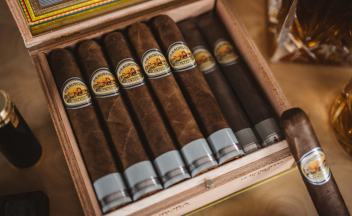
How to Cut a Cigar
How to Cut a Cigar
There are different ways to cut a cigar each with its own advantages and disadvantages. This guide will provide you with the best techniques and what each style of cigar cutter brings to the smoking experience. You will learn how to cut a cigar and how to up your smoking game.
How to Cut a Cigar
Premium cigars feature a small piece of tobacco, called the cap, that fits over the head of the cigar and helps hold each layer of tobacco in place. Some cigar makers utilize a double or triple cap where extra leaves are used to reinforce the head. These form the seams or lines you see around the head of the cigar. The finest Cuban cigars, like a Cohiba Siglo VI, always feature a triple cap.
For you to draw through the cigar, a portion of the cap must be removed without completely removing the cap. This is where your choice of cigar cutter comes into play. Each type of cutter has its own unique benefits and drawbacks that can affect your cigar experience. Here is a brief rundown of how the most popular styles of cutters and how to use them.
Guillotine
Guillotine cigar cutters are the most popular type and deliver a straight cut. This removes a large portion of the cap for a full draw and broader flow of the tobacco’s nuances. Guillotine cutters can be found in single blade styles or, the more preferred, double blade format.
- How to use: Line up the cigar in the guillotine’s aperture so that the blades will cut above the visible cap line that rings the top of the cigar. If you can’t see any lines, then line up the cutter where the head of the cigar begins to curve, known as the shoulder. While holding the cigar and cutter steady, make a smooth and decisive cut.
Single blade guillotines can sometimes fray the edge of the cigar as the blade reaches the outer edge of the cigar, whereas double guillotines cut from the outside in to lessen the chance of leaf damage. Cutting too far down or cutting at an awkward angle can be a drawback of both single and double blade guillotines. So, take your time and line it up for just the right cut.
The versatility that guillotines offer far outweigh their disadvantages. Cigar guillotines cut an incredible range of shapes and sizes, with many of today’s standard guillotines accommodating cigars of up to a 54-ring gauge and some even as high as an 80-ring gauge. Learn more about ring gauge here.
Scissors
Cigar scissors are classic cigar cutters that operate much in the same way as double-blade guillotines, providing a straight cut that offers a large aperture through which to draw. So, also like guillotines, great care should be taken to not cut below the cap.
- How to use: While holding the cigar steady, line up the opened scissors so that the blades will cut just above the cap line. You can partially close the scissors to better line up where you want to cut. Carefully squeeze the handles together in one smooth and easy motion.
A traditional favorite of business settings, cigar lounges, bars and restaurants, cigar scissors bring a touch of elegance and style to cigar preparation. Cigar scissors can range from large desktop models to smaller pocket-sized variations perfect for when you are out and about.
Punch
Punch cutters feature a small circular blade that cuts or punches a hole at the end of the cigar. Punch cutters remove the risk of cutting off too much of the cap leaf. One of the drawbacks is that pushing too hard with a punch can split the cap. Also, these cutters are not designed for all cigar shapes, so are only good if you smoke Parejos or straight cigars.
- How to use: Line up the punch cutter’s blade so that it is flush against the center of the cigar’s head. You can lightly twist the cutter to score the leaf where you plan to cut. You can adjust the placement of the cutter accordingly. When ready to make the cut, press the cutter carefully into the cigar while rotating the cutter back and forth in a smooth twisting motion and remove.
While some argue that a punch cutter’s hole is too small to get the full character of the tobacco, others still suggest the smaller hole helps to better focus the flavor and body of the smoke onto the palate. Either way, if you find the hole is too small, you can make two or three overlapping cuts for a larger, improved draw.
V-Cut
The V-Cut, alternately known as a cat-eye or wedge cutter, is the most unique of all cigar cutters and also one of the trickiest to use. The V-cutter removes a V-shaped wedge out of the head of the cigar. The idea is that the wedge shape’s dual-surface areas help deliver a more complex smoke that unleashes the full spectrum of the tobacco’s body and taste.
- How to use: For traditional V-cutters, insert the cigar and firmly press it into the V-cutter’s aperture so that the cigar band or front of the cigar is facing up. This helps maintain a cleaner, more efficient cut, especially with pressed cigars. Quickly and confidently press the blade into the cigar. For modern, sliding blade V-cutters, use the same method as for guillotine cutters.
Traditionally each V-cutter is designed for a specific range of sizes or shapes, severely limiting their versatility. Newer guillotine-like designs allow for greater flexibility in sizes and shapes while also simplifying the cutting action.
Cutting Without a Cigar Cutter
Just because you don’t have a cigar cutter doesn’t mean you have to go without your smoke. The ways to “cut” your cigar are only limited by your imagination and ability to improvise. The main goal is to remove enough of the cigar’s cap so that you can draw through the cigar, and this is easily done with the simplest of objects.
Knives, fingernails, pens, toothpicks, or just about anything else that cuts, slices, jabs, or pokes will work. This means you don’t have to go searching for your misplaced cigar cutter, nor do you have to lug around a bulky cutter wherever you go. The flipside, however, is that by not using a cutting tool specifically made for cigars, you run the risk of damaging your cigar or putting yourself at greater risk. So, no matter what you use to cut your cigars, always do so with the greatest of care and caution.
How to cut a torpedo cigar
While most cigar cutters will easily handle Parejos or straight cigars, Torpedoes and other shaped cigars can be a bit trickier. Since Torpedoes are more sharply curved, they require a more elaborate cap. This can make it difficult to know just where to cut.
Cutting too much off your prized Montecristo No. 2 can make for a very bad day, so when cutting a Torpedo, remember that less is always more. If using a guillotine or cigar scissors, cut just above the highest visible cap line. If using a V-cut, make sure the Torpedo is perfectly centered before cutting to lessen the risk of a damaged leaf.
Cutting your cigar with confidence
No matter which cutting method you use, ensure the cutter is sharp and that you make your cut with confidence. WIth a good cutter you can take the next leap into the wonderful world of premium cigars. Upgrade the cigars you smoke and put your cutting knowledge to the test with an authentic Cuban.
Apr 14, 2025
Last Modified: Apr 14, 2025

Table of Contents




